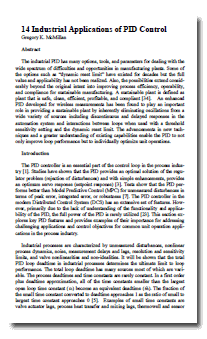 Back in May in a post, Industrial Applications of PID Control, I highlighted a new book ModelingAndControl.com blog’s Greg McMillan was writing, PID Control in the third Millennium – Lessons Learned and New Approaches. In the post, Greg provided a free chapter for download, Industrial Applications of PID Control.
Back in May in a post, Industrial Applications of PID Control, I highlighted a new book ModelingAndControl.com blog’s Greg McMillan was writing, PID Control in the third Millennium – Lessons Learned and New Approaches. In the post, Greg provided a free chapter for download, Industrial Applications of PID Control.
I’ve received an email from Greg that he has updated the chapter, and I’ve linked to this updated version above and in the May post. Greg describes the changes he made [emphasis and hyperlink added]:
At first, I thought I didn’t have time to offer the explanations and additional information requested by the reviewer. I found the time and I am glad I did.
It took extra effort but I think it is worthwhile to show that the equations for loop performance developed by me and Greg Shinskey have a solid foundation in first principles and the PI algorithm and are essential for a conceptual understanding of what is important and when in dynamics and tuning. There is so much misinformation and confusion that these equations can eliminate. For the life of me, I don’t understand why these equations are not the guiding light for process control improvements.
Other changes in the downloadable chapter that Greg highlighted include:
- Added a definition of sustainable manufacturing to the abstract
- Added 7 pages and 10 equations on the development and the significance of the equations for the ultimate and practical limits to loop performance
- Added an explanation of Figure 14-3. The depicted PID algorithm is not a specific structure but a specific form (ISA Standard). I made it clearer that the form with setpoint weight factors can provide all 8 of the structures in Figure 14-3 by setting the factors.
- Added an option to use direction velocity limits and dynamic reset limit at the end of the Open Loop Backup (Kicker subsection)
- Added a note on page 43 for the Unit Operation Examples that the enhanced PID as a valve position controller provides a fast, easy, and inexpensive way to increase production rate of any of the continuous and fed-batch operations discussed.
It’s definitely worth downloading and reading the chapter to understand the equations about which Greg is so emphatic.
